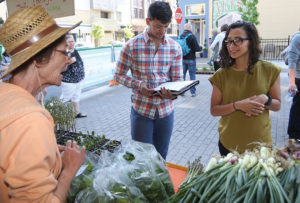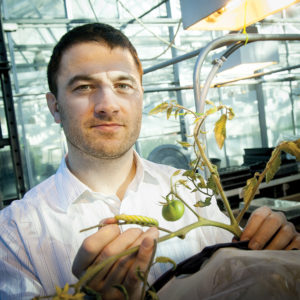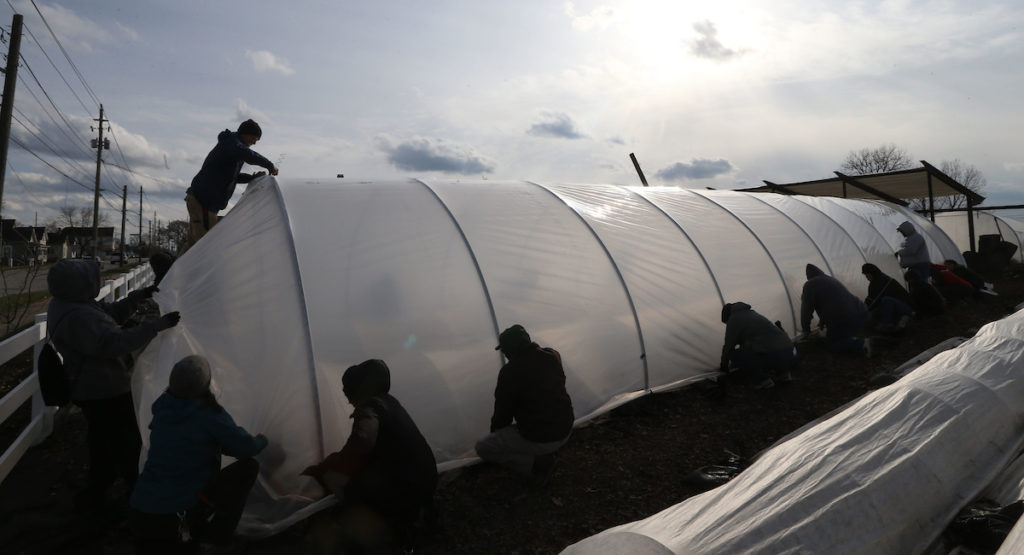The Science of Buying Local
Blue and white tent tops dot the northwest corner of Purdue’s Memorial Mall, shading potted begonias and open cartons of brown eggs. Next to glossy red tomatoes, a handwritten cardboard sign reads “local, picked fresh,” causing staff and students to stop and inspect them.
The Purdue Farmers Market — celebrating its 10th year this May — is one of 8,761 farmers markets in the U.S. Department of Agriculture (USDA) database, a testament to the surge in demand for local products over the last 10 to 15 years. Community-supported agriculture organizations, farm-to-table restaurants and even grocery chains are marketing local ingredients.
“Consumers want that proximity,” says Ariana Torres, assistant professor in horticulture and landscape architecture and agricultural economics. “The closer you are, that produce is harvested at the peak of ripening, instead of green when it’s imported from other states or countries. This makes the produce fresher and more flavorful and sometimes preserves nutrients. That’s why most crops have a price premium for being local.”
Tunnel vision
In response to local food demand, many farmers have diversified what they grow, which has dramatically increased the use of high tunnels. Also known as hoop houses, they are constructed by covering a frame of arched metal ribs with plastic sheeting. From 2005 to 2015, more than 10,000 new high tunnels were constructed in the U.S., largely due to a funding initiative from the USDA’s Natural Resources Conservation Service.
You can find them on the periphery of large Indiana corn and soybean operations, packed sky-high with trellised tomatoes, cucumbers and peppers. You can find them on for-profit urban farms growing peppers for subscription boxes. Retired hobbyists and young beginners — demographic groups who weren’t farming 10 years ago — spend hours pruning and harvesting each morning while it’s still cool.
By using solar heat and natural cooling, high tunnels create a more controlled growing environment that protects crops from extreme weather. This extends the growing season and increases yield for high-value crops such as tomatoes and cucumbers, which are then sold directly to consumers at a premium price.
High tunnels are more affordable for local growers than temperature-controlled greenhouses. However, the hybrid environment poses unique production challenges. “Sometimes a high tunnel has the benefits of growing in the field. Sometimes it has the benefits of a greenhouse. Sometimes it’s worse than both of those environments,” says Laura Ingwell, assistant professor of entomology.
The shift to local production happened so quickly that science is still trying to catch up, including identifying sustainable ways to control pests, maintain soil health and compete in the local marketplace.
“These local food systems have value,” says Lori Hoagland, associate professor of horticulture and landscape architecture, “but now scientists are asking, ‘How do we catch up local production practices to be more sustainable?’”
Natural predators
Ingwell and Ian Kaplan, professor of entomology, are performing some of the first studies on ways to control pests in high tunnels.
Popular belief held that pest levels in high tunnels may be lower than in the field. “We found the opposite,” says Kaplan, who was recently awarded the 2019 Agricultural Research Award from the College of Agriculture. Pest populations are higher in high tunnels, as pests enter and establish themselves when the sidewalls are open to prevent crops from overheating. The result: more pesticides are needed, which is problematic in an enclosed space with labor-intensive crops.
“We are really lacking on the science side in terms of what the breakdown of these chemicals is in high tunnels, and what risk they pose for workers and consumer safety,” Ingwell says. In search of an alternative, Kaplan and Ingwell have found some success with insect exclusion netting, a mesh that keeps larger pests out while still allowing ventilation. They have already passed this strategy on to local farmers fighting cucumber beetles. They also conducted one of the first studies on biocontrol in high tunnels, a common strategy in commercial greenhouses. “If you had an aphid outbreak, for example, you would order ladybugs and release them into the tunnel, then hope they stay and kill things,” Kaplan explains.
“The more diverse the landscape is, the harder it is for things like pests and pathogens to navigate.” LAURA INGWELL, assistant professor of entomology

- The demand for locally grown produce has surged in the past 10 to 15 years.
- High tunnels help meet that demand. These structures use solar heat and natural cooling to extend the growing season, increasing yield for high-value crops sold locally at a premium price.
- High tunnels, however, pose new agricultural challenges that scientists are working to overcome.
- Ian Kaplan and Laura Ingwell of the Department of Entomology are studying sustainable methods for pest control in high tunnels, including the use of insect exclusion netting or introduction of natural insect predators.
- To keep soil from degrading despite the intense cultivation in high tunnels, Associate Professor Lori Hoagland has found that using green manures as fertilizers can improve soil health in these intensively managed systems and help plants resist pathogens that cause diseases.
- Consumers buying local products want freshness and quality, but are also cultivating trust with local producers, says Assistant Professor Ariana Torres, whose research examines how direct-to-consumer markets influence grower and consumer decisions.
- Diversity in agricultural production gives consumers more control over their purchases, based on their priorities and pocketbook.
In a tunnel with open sides, however, predators can migrate away. After unsuccessfully attempting to screen predators inside, Kaplan and Ingwell found that diversifying the environment was more effective. To attract predators, they released herbivore-induced plant volatiles, chemicals that plants naturally release during pest attacks to attract insect predators that eat those pests. Once attracted, predators were enticed to stay by diversifying the high tunnel environment with pollen and nectar sources.
“The more diverse the landscape is,” Ingwell says, “the harder it is for things like pests and pathogens to navigate.”
Belowground diversity is just as important. “Now we are looking at how the diversity of microbes in soil impact a plant’s resistance to pests aboveground,” Kaplan says.
Microbe nation
That’s where Hoagland’s work comes in. She studies the challenges of local production pertaining to soil health and quality — which is crucial for profits, but also for the health of plants, consumers and the environment.
“Soil is something that was built up over thousands of years, and within any given soil, there is an entire ecosystem of microbes that are responsible for cycling nutrients and fighting pathogens,” Hoagland says. “Any time you start cultivating soil, you are burning up some of those resources.”
The intense cultivation of high-tunnel soil degrades its quality. Field crops can be rotated, but most high tunnels are fixed, with incentive to plant the same high-value crops repeatedly. Higher production also means that plants need more soil nutrients.
“You can keep putting fertilizers down there as a temporary fix,” Hoagland says, “but the soil will keep sliding in quality.” Using commercial fertilizers and animal manures can cause nitrogen or phosphorus to escape into the atmosphere, contaminating air and water quality, or build up in soil, causing imbalances in plant uptake of other essential nutrients.
Hoagland’s work has shown that degraded soil also makes plants more susceptible to pathogens, which can compromise plant health and even make soils and plants more susceptible to pathogens that cause gastrointestinal illnesses in humans. She is trying to overcome these challenges by developing new ways to manage soil health. In a three-year study of soil in high tunnels, she found that including green manure fertilizers (dehydrated plant materials or cover crops that are tilled under) was effective in increasing microbial activity to maintain soil and plant health. Hoagland is also collaborating with breeders to develop new plant varieties that are better adapted to local production systems.
Trust for sale
“Why would a farmer invest in a high tunnel? Why would a farmer start canning? Why would a farmer grow multiple crops? Every question that I look into,” Torres says, “the answer is the market.” Her research aims to promote economic sustainability for specialty crop growers.
When you buy from a local farmer, Torres explains, you are buying freshness, quality and trust. Her research shows that growers selling directly to consumers are less likely to certify as USDA organic, since the trust and transparency created by this relationship commands a similar price premium.
To help growers determine a premium price in their area, Torres is currently collecting data and establishing long-term pricing reports for Indiana’s farmers markets. These benchmarks help growers develop market strategies for particular seasons and crops.
Options for everyone
Despite dramatic increases, local food production still represents a small share of the national food supply. Not everyone can afford to pay $4 per pound for local tomatoes, and population growth is creating increased demand for affordable food.
“The local food market trend, in my eyes, created two trends: small, diversified farmers aiming to reach those premium local markets, and big farmers becoming even bigger to fit markets for people who just want a fresh tomato for the best price,” Torres says. “If you sell locally, you will get price premiums; if you sell nationally via wholesale, you make money on volume.”
This diversity in agricultural production gives consumers more choices based on their priorities and pocketbook. “Everyone is winning,” Torres says.
Purdue Agriculture, 615 Mitch Daniels Blvd, West Lafayette, IN 47907-2053 USA, (765) 494-8392
© 2024 The Trustees of Purdue University | An Equal Access/Equal Opportunity University | USDA non-discrimination statement | Integrity Statement | Copyright Complaints | Maintained by Agricultural Communications
Trouble with this page? Disability-related accessibility issue? Please contact us at ag-web-team@purdue.edu so we can help.



